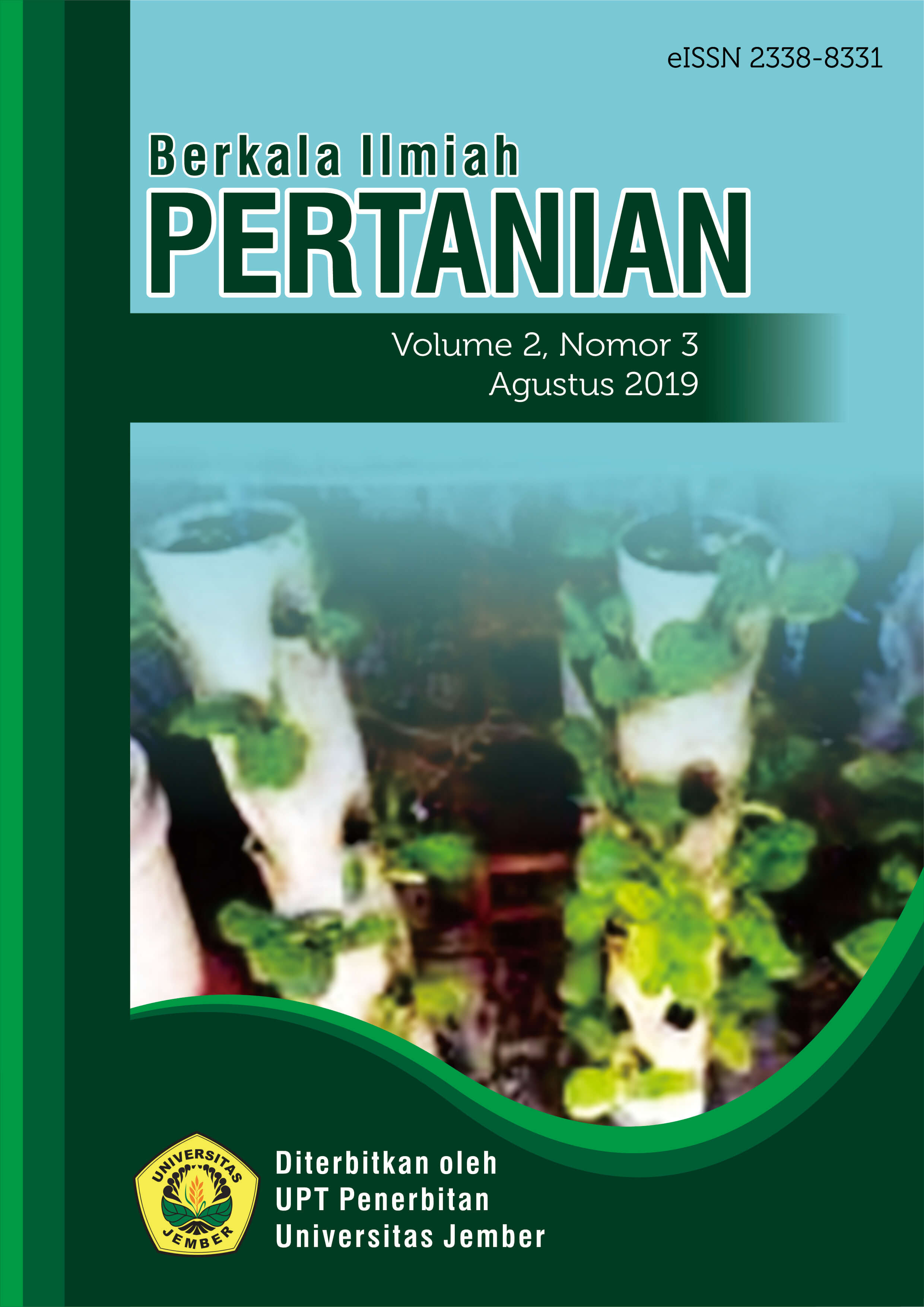PENGARUH PEMUPUKAN KOMPOS BLOTONG DAN PUPUK ORGANIK CAIR ECENG GONDOK TERHADAP INFEKSI ENDOMIKORIZA DAN PRODUKSI TANAMAN SORGUM (Sorghum bicolor (L.) Moench) PADA LAHAN PASIR PANTAI PASEBAN KABUPATEN JEMBER
Abstract
ABSTRACT
Sandy land has a considerable potential to resolve the problem of the narrowing area of agricultural land in Indonesia. Improvement of sandy land quality which belongs to the marginal land is necessary in order to increase its productivity, for example through the addition of compost and organic liquid fertilizer. This research aims to know the effect of blotong compost and organic liquid fertilizer of Eichhornia crassipes to endomycorrhizal infection and the production of sorghum plants. The experimental design used was factorial completely randomized block design with 2 factors and 3 replicates. The first factor was dose of blotong compost which consists of 3 levels, i.e. 0, 20, and 40 tons blotong compost /ha. The second factor was concentration of the organic liquid fertilizer of Eichhornia crassipes consists of 4 levels, i.e. 0, 10, 25, and 40% of the organic liquid fertilizer of Eichhornia crassipes. Further data obtained were analyzed using ANOVA, followed by Duncan Multiple Range Test (DMRT) for significantly different data. The results showed that the application of blotong compost increase soil Corganic, total soil microorganisms, plant height and lowering endomycorrhizal infection. Optimal fertilizing compost blotong dose is 40 tons/ha. The application of organic liquid fertilizer of Eichhornia crassipes increase the total soil microorganisms with optimal concentration of 40%, as well as reducing endomycorrhizal infection. The combination treatment of 20 tons of compost blotong/ha and 10% organic liquid fertilizer of Eichhornia crassipes already enhance the growth and production of sorghum, but the maximum growth and plant production is achieved with the addition of 40 tons of compost blotong/ha and 40% organic liquid fertilizer of Eichhornia crassipes.
Keywords: Root infection, sandy land, blotong, Eichhornia crassipes, sorghum
ABSTRAK
Lahan pasir pantai memiliki potensi cukup besar untuk mengatasi masalah semakin menyempitnya luasan lahan pertanian di Indonesia. Perbaikan kualitas lahan pasir pantai yang termasuk ke dalam lahan marginal sangat diperlukan agar dapat meningkatkan produktivitasnya, misalnya melalui penambahan pupuk kompos dan pupuk organik cair (POC). Penelitian ini bertujuan untuk mengetahui pengaruh pemupukan kompos blotong dan POC eceng gondok terhadap infeksi endomikoriza dan produksi tanaman sorgum. Penelitian ini menggunakan rancangan acak kelompok (RAK) dengan 2 faktor dan 3 ulangan. Faktor pertama yaitu dosis kompos blotong yang terdiri atas 3 taraf yaitu 0, 20, dan 40 ton kompos blotong/ha. Faktor kedua yaitu konsentrasi POC eceng gondok yang terdiri atas 4 taraf yaitu 0, 10, 25, dan 40% POC eceng gondok. Data dianalisis menggunakan ANOVA. Apabila antar perlakuan berbeda nyata maka dilakukan uji lanjut menggunakan Duncan Multiple Range Test (DMRT). Hasil penelitian menunjukkan bahwa pemberian blotong dapat meningkatkan C-organik tanah, total mikroorganisme tanah, tinggi tanaman, serta menurunkan infeksi endomikoriza. Dosis pemupukan kompos blotong yang optimal adalah 40 ton/ha. Pemberian pupuk organik cair eceng gondok dapat meningkatkan total mikroorganisme tanah dibanding kontrol dengan konsentrasi optimal 40%, serta menurunkan infeksi endomikoriza. Kombinasi perlakuan 20 ton kompos blotong/ha dan 10% POC eceng gondok sudah dapat meningkatkan pertumbuhan dan produksi tanaman sorgum, namun pertumbuhan dan produksi tanaman maksimum dicapai pada perlakuan penambahan 40 ton kompos blotong/ha dan 40% POC eceng gondok.
Kata kunci: Infeksi endomikoriza, tanah pasir pantai, blotong, eceng gondok, sorgum.
Authors who publish with this journal agree to the following terms:
1.Authors retain copyright and grant the journal right of first publication with the work simultaneously licensed under a Creative Commons Attribution-NonCommercial 4.0 International License that allows others to share the work with an acknowledgement of the work's authorship and initial publication in this journal.
2.Authors are able to enter into separate, additional contractual arrangements for the non-exclusive distribution of the journal's published version of the work (e.g., post it to an institutional repository or publish it in a book), with an acknowledgement of its initial publication in this journal.
3.Authors are permitted and encouraged to post their work online (e.g., in institutional repositories or on their website) prior to and during the submission process, as it can lead to productive exchanges, as well as earlier and greater citation of published work (See The Effect of Open Access).

















